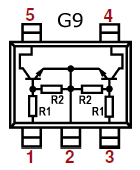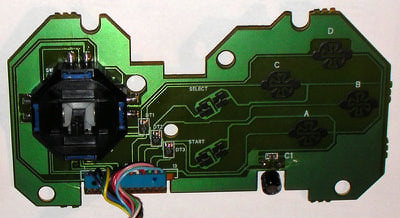Joypad: Difference between revisions
m (Registers) |
mNo edit summary |
||
| Line 4: | Line 4: | ||
The [[SYSTEM_IO]] ($C0044A) [[BIOS calls|BIOS call]] can be used to read inputs more easily: it sets values in the [[BIOS_RAM_locations|BIOS RAM]] which gives currently pressed, state change, and repeat values for both joypads ports. | The [[SYSTEM_IO]] ($C0044A) [[BIOS calls|BIOS call]] can be used to read inputs more easily: it sets values in the [[BIOS_RAM_locations|BIOS RAM]] which gives currently pressed, state change, and repeat values for both joypads ports. | ||
Only one output is used: [[Pinouts|OUT3]], which is connected to the D button input. This loop is used for detection (D = 0 if OUT3 = 1). | |||
==NeoGeo CD joypads== | ==NeoGeo CD joypads== | ||
| Line 13: | Line 15: | ||
The NeoGeo CD joypads use membrane switches and springs for the 4 directions (replacement part ?) which directly set the corresponding inputs to ground. | The NeoGeo CD joypads use membrane switches and springs for the 4 directions (replacement part ?) which directly set the corresponding inputs to ground. | ||
The buttons are buffered with 3 | The buttons are buffered with 3 dual NPN "digital transistors" marked G9, providing good press detection even if the carbon contacts have high resistance. | ||
[[Category:Base system]] | [[Category:Base system]] | ||
[[Category:Controllers]] | [[Category:Controllers]] | ||
Latest revision as of 22:53, 22 June 2016
Regular NeoGeo joypads or joysticks have 4 directions and 6 button switches.
Registers used to read the switches states are REG_P1CNT, REG_P2CNT, and REG_STATUS_B.
The SYSTEM_IO ($C0044A) BIOS call can be used to read inputs more easily: it sets values in the BIOS RAM which gives currently pressed, state change, and repeat values for both joypads ports.
Only one output is used: OUT3, which is connected to the D button input. This loop is used for detection (D = 0 if OUT3 = 1).
NeoGeo CD joypads

The NeoGeo CD joypads use membrane switches and springs for the 4 directions (replacement part ?) which directly set the corresponding inputs to ground.
The buttons are buffered with 3 dual NPN "digital transistors" marked G9, providing good press detection even if the carbon contacts have high resistance.
